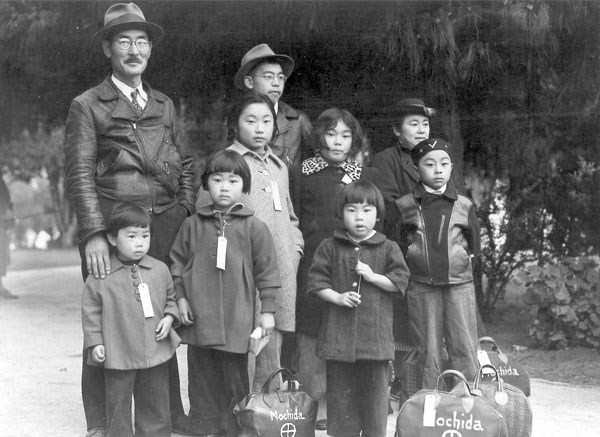Aleutian World War II National Historic Area
Aleutian World War II National Historic Area has recorded stories from military veterans, home front workers, and Native Aleuts who were evacuated and interned during the war.
Blue Ridge Parkway
Driving Through Time: The Digital Blue Ridge Parkway features interviews with people who lived in communities along the Blue Ridge Parkway, workers who designed and built the parkway, and former Park Service employees.
Ellis Island / Statue of Liberty National Monument
Fort Hunt, George Washington Memorial Parkway
The Fort Hunt Oral History Project: P.O. Box 1142 documented the stories of World War II veterans who carried out critical intelligence assignments at the site, known by its secret code name, P.O. Box 1142.
Golden Gate National Recreation Area
The oral history program at Golden Gate National Recreation Area (GGNRA) has been ongoing almost since the creation of the park in 1972. The Park Archives currently holds hundreds of interviews which cover a range of topics and feature voices of those who have been personally involved with the lands that make up the GGNRA. In addition to the voices of former military figures, Alcatraz prisoners, and park officials, the GGNRA’s Oral History Collections also include survivors of the 1906 Earthquake, visitors of the former Cliff House and Sutro Baths recreation centers, army wives and children, lifelong dairy farmers, students of the World War II-era Army Intelligence Language School at Crissy Field, environmental activists who helped preserve the park from development, and many others. The collections represent unique perspectives on the history of the park and of the San Francisco Bay Area.
Lewis and Clark National Historic Trail
The Lewis and Clark National Historic Trail recognizes that Native Americans have their own ways of viewing what was known as the Corps of Discovery. Hear tribal perspectives on the Lewis and Clark mission at the Trail Tribes website.

Photograph by D. Lange (May 8, 1942); Bancroft Library, University of California, Berkeley, WRA No. C-153.
Little Rock Central High School National Historic Site
The Little Rock Central High School National Historic Site has collected video and audio interviews with the Little Rock Nine and other members of the community who witnessed or took part in the integration efforts of 1957-1959.
Manzanar National Historic Site
With the help of partners, Manzanar National Historic Site shares interviews with Japanese Americans incarcerated at the War Relocation Center in eastern California during World War II. Some of the stories are available online through California Revealed, the Denshō archive, and Manzanar's YouTube channel.
Pearl Harbor National Memorial
The Pearl Harbor audio archive comes from oral history video interviews with Pearl Harbor Survivors. The oral history interviews with civilians and military personnel from both the United States and Japan document and preserve the experiences and memories of those who witnessed the Pearl Harbor attack on December 7, 1941. Transcripts of from these interviews are also available on the park website.
Yosemite National Park
J. D. Swed still remembers the first time he saw Yosemite Valley in the early 1970s when he joined the National Park Service as a seasonal ranger. The interview with J.D. Swed is available on YouTube.
Women in Alaska Parks
“Women Making History In Alaska Parks” features audio and transcripts of oral history interviews with women who worked in National Park Service units in Alaska.
StoryCorps Midwest
In partnership with StoryCorps, the Midwest Region of the National Park Service celebrated the 2016 NPS Centennial through sharing and preserving favorite parks memories. The Stories from the Midwest project toured the region to record conversations from the local communities, visitors, and employees of the parks, using the StoryCorps interview model: a 40-minute conversation between two people who know each other well.
StoryCorps: Gateway Arch National Park
Roger Smith and Terry DiBlasi are veteran mechanics of the National Park Service at Gateway Arch National Park (formerly Jefferson National Expansion Memorial) in St. Louis, Missouri, which includes the Gateway Arch. They work on the tram that takes visitors up and down the 630 foot high Arch.
StoryCorps: Nicodemus National Historic Site
The only remaining western town established by African Americans during the Reconstruction Era following the Civil War, the town of Nicodemus is symbolic of the pioneer spirit of African Americans who dared to leave the only region they had been familiar with to seek personal freedom and the opportunity to develop their talents and capabilities. Barbara Christian and Thomas Wellington share memories and stories about Nicodemus.
StoryCorps: Midwest Regional Office
Stationed at the NPS Midwest Regional Office in Omaha, National Park Service Park Ranger and Wildland Firefighter, J. Michael Johnson, talked with his wife, Joyce Van Horne, about his passion for his work.
StoryCorps: Minuteman Missile National Historic Site
Retired Air Force Major Glenn Plumb Sr. talked to his son, Glenn Jr. about retrofitting minuteman missiles in South Dakota in the early 1970s. Growing up near what is now Badlands National Park, Glenn Jr.described how he developed a love for buffalo that led him to be a chief wildlife biologist for the National Park Service.
StoryCorps: Mount Rushmore National Monument
Bill and Cheryl Schreier talk about their life as a 'dual career couple' in the National Park Service.
StoryCorps: Harry S Truman National Historic Site
Three Master Gardeners for the Harry S Truman National Historic Site -- Gretchen Lathrop, Lynn James, and Janeil Egger -- talked about working at President Truman's home in Independence, MO, and balancing Master Gardener practices with the sometimes contradictory responsibilities of historic cultural landscape maintenance.
StoryCorps: George Washington Carver National Monument
Lana Henry and her daughter Bethany Rosenbaum described their love of the National Park Service. Lana has worked at George Washington Carver National Monument for almost four decades and Bethany also envisioned a career with the NPS.
Last updated: September 26, 2024

